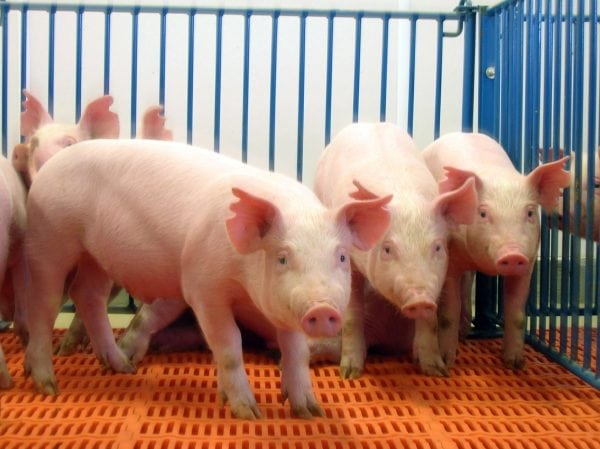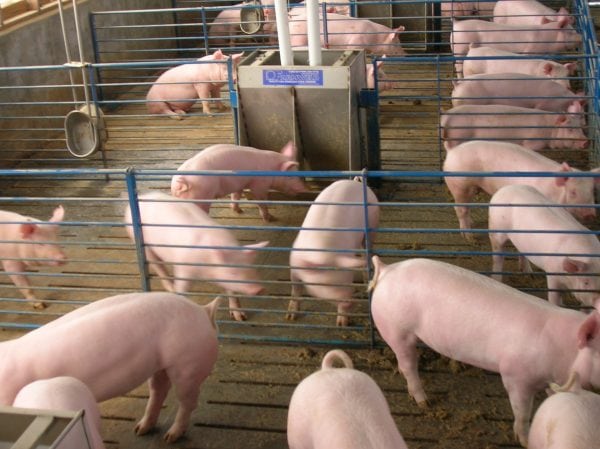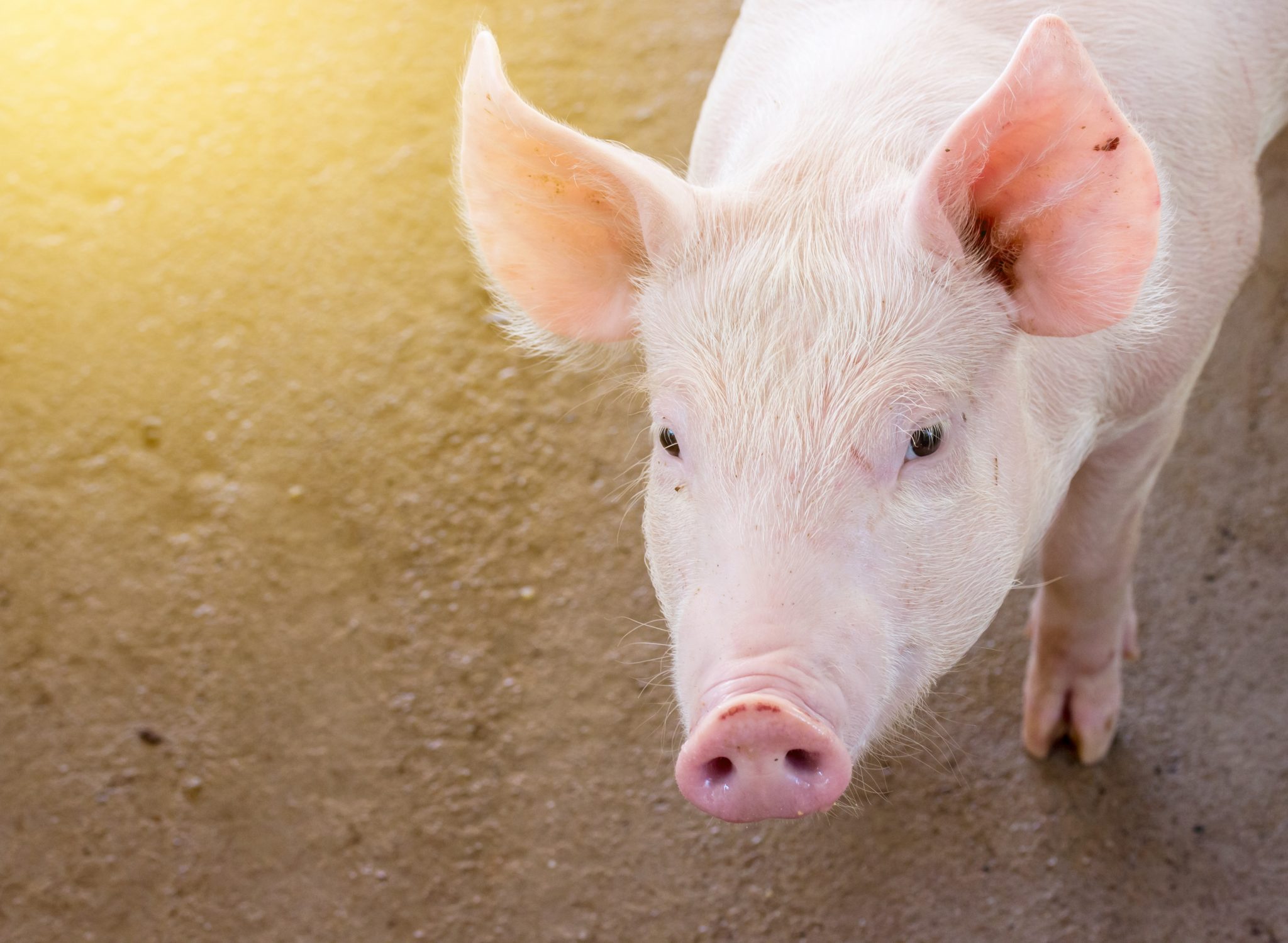Farming

Swine finishing operations require less labor than farrow- to-finish operations, which is attractive to producers who have other labor-intensive enterprises on their farms but who also want to maintain a market-hog operation. In farrow-to-finish operations, the demands for labor and management are greatest in the farrowing house and the nursery and are least demanding during the finishing phase. About 90 percent of the labor and management is complete when the pigs enter the finishing phase of the operation.
Ideally, the only remaining tasks during the finishing phase are mixing feed and adjusting water and feeders while waiting for market day.
Feeding feeder pigs, whether they are pigs you purchased or contracted to feed, presents special problems and requires more management than feeding similar pigs you raised yourself. These special problems include poor performance, decreased disease resistance, and high death losses, usually within 3 to 4 weeks following arrival. The stress of transportation and mixing can leave these pigs weak and susceptible to disease.
A good feeder-pig finisher must reduce the stresses of sale and shipping, including the following:
- Fatigue
- Thirst
- Hunger
- Social problems
- Changes in diet, housing, and temperature
New feeder pigs often get sick because of these stresses, but with prompt and proper care the pigs can reach a market weight (235 to 260 pounds) in about 110 days.
Purchasing Feeder Pigs 
You can avoid many problems associated with purchased feeder pigs through careful purchasing. Feeder pigs should appear healthy, vigorous, and alert. All males should be castrated and healed, and tails should be docked on all pigs. Ideally, all pigs should come from the same farm, which helps eliminate the problems that accompany commingled pigs. If all pigs come from one farm, that farm should have a good health program, including parasite control and necessary vaccinations.
Local-source, one-owner pigs lend themselves to better trace back and adjustments if problems occur during the receiving period. In addition, local-source, one-owner pigs are less susceptible to major problems than are pigs purchased in individual groups from different locations. These pigs have mortality rates that can range from 10 to 15 percent.
Transportation
Transportation is the first point at which the new owner can begin to relieve stress and get feeder pigs started properly. The truck or trailer should be disinfected between loads of pigs and bedded with wheat or oat straw in winter and wet sawdust or sand in summer. Shield the pigs from direct drafts, but provide adequate ventilation.
Load the pigs promptly after purchase, but minimize excitement and abuse. Divide the load (by partitions) into groups of 50 pigs or fewer to make them more comfortable. Allow adequate space for each pig (table 1). Attention to these details is often the difference between a successful feeder-pig finisher and a health and economic failure.
Table 1. Space Requirements for Transporting Feeder Pigs.
| Pig Weights, lb | Winter, sq ft | Summer, sq ft |
|---|---|---|
| 40 to 50 | 1.00 | 1.25 |
| 50 to 75 | 1.25 | 1.50 |
| 75 to 100 | 1.50 | 2.00 |
Housing
Improper housing for newly arrived feeder pigs frequently causes problems. Removing all other pigs from the receiving facility reduces the chances of a disease outbreak. All-in/all-out movement of feeder pigs can significantly reduce disease losses. If possible, isolate new pigs from those already on the farm. At the very least, provide semi-isolation during the first 2 to 3 weeks by leaving one or two empty pens between new arrivals and the other pigs. Never mix new pigs with others, especially “tail-ender” pigs.
Facilities and equipment should be thoroughly cleaned and disinfected a week or more before the new pigs arrive. Soak floors, walls, feeders, and waterers with sprinkler hoses, then scrape, brush, or use a high- pressure spray to remove all manure and caked feed. Hot, soapy water and a 2 percent lye solution are excellent for the final cleaning. Rinse and spray with a cresylic acid, iodine, phenol-derivative, or fumigant-type disinfectant.
Proper temperature and adequate ventilation are especially important to the new arrival. The ideal temperature is approximately 75 degrees F; however, a warm, dry sleeping area is most critical. In controlled- environment buildings, provide 1.8 to 3 square feet of floor space for 20- to 50-pound pigs and 4 to 5 square feet for 50- to 100-pound pigs. If you house pigs in outside lots, provide 3 to 4 square feet of well-bedded sleeping area for each pig.
Sort feeder pigs by weight when they arrive. Weight variation within each pen should be plus or minus 10 to 15 percent of the average weight. Limit group sizes to only 25 to 30 pigs per pen to reduce fighting, promote faster growth, and improve efficiency.
Water consumption upon arrival is extremely important. Provide one waterer per 20 pigs. Some pigs may require assistance in learning to drink from a strange watering device. For this reason, waterers should be altered so that they will drip for the first 24 hours after the pigs arrive on the farm. This will aid in teaching the pigs where the water source is and how to use it.
If pigs are not visibly sick upon arrival, provide fresh, nonmedicated water for the first 24 hours. When necessary, provide medicated water using inline proportioners or barrel waterers. Provide one feeder space or hole for every three to four pigs. Avoid feeders with heavy trough lids or narrow feeder spaces that discourage pigs from eating. Fasten lids in the open position for a few days if necessary to promote feed consumption. Provide a “sick pen” where pigs can receive extra observation, attention, supplemental heat, and rest from pig traffic and activity.
Feeding the New Arrivals
Nutrition and feed management of the new arrivals are important because these factors influence pig performance and serve as measures of pig health and well-being.
During the first week to 10 days, you may need to limit-feed the pigs. Allow the pigs to consume about 90 percent of full feed to reduce gut edema and scouring problems. In 40- to 60-pound pigs, this generally means about 2 pounds per head per day. Feeding on a clean floor during the first few days allows closer observation of the pigs’ appetite and trains them in proper dunging patterns.
A special receiving diet may reduce nutrition-related health problems. A diet formulated for lower feed intake and containing palatable, high-quality ingredients (whey, fish meal, dried distillers or brewers grains, etc.) should be fed for 1 to 2 weeks after arrival. Then change the feed to a typical pig grower diet.
Water is important to feeder pigs because it is not available during shipping. Stress-related scours often result in dehydration shortly after arrival. A 40-pound pig should consume about 1/2 gallon of water per day. When necessary, use palatable water medications, and do not limit the intake of water. Flavorings (like a fruit- flavored gelatin mix) may improve palatability.
Health
Disease in purchased feeder pigs is often the most limiting factor in making a profit. Feeder pigs are highly stressed and are at risk of breaking with disease during transport or within a short period following delivery.
Commingling feeder pigs from more than one source often results in disease and death loss. Pigs that are mixed together from different sources are exposed to disease-causing organisms that may not have been present at their original farms. Because they have not had a chance to develop immunity to those organisms, the pigs may break with disease as a result of this exposure.
Disease breaks are even more likely when the pigs are stressed by shipment over long distances, deprived of feed or water, or exposed to bad weather. These stressors decrease the ability of their immune systems to respond to disease challenges. The ideal source herd is one that is only a short distance away, thus reducing the stress of transportation.
The best way to prevent disease is to purchase feeder pigs from a single source of high-health pigs, thus allowing you to know something about that herd’s disease and management history. Ask about the source herd’s health history. Have there been porcine reproductive and respiratory syndrome (PRRS), salmonella, erysipelas, dysentery (bloody scours), Actinobacillus pleuropneumoniae, influenza, Mycoplasma hyopneumoniae, ileitis, or other diseases in the herd? If particular disease problems have occurred, work with the owner of the source herd to ensure that a proper vaccination, management, or medication program is in place to help prevent or control the disease before you purchase the pigs, or at least have a plan in place to protect the health of the pigs once they arrive on your farm. Depending on the disease problem, it might be to your benefit to find an alternative source of healthier pigs.
If sufficient numbers of pigs cannot be obtained from a single-source, high-health herd, the next best choice is a graded feeder pig sale with a well-enforced health program. The highest health risk occurs in pigs purchased from multiple-source owners, who have unknown health practices and diseases, and when pigs are commingled at a frequently used buying point.
Unless other disease problems have been present in the source herd, the only vaccinations that are routinely recommended before sale are erysipelas and circovirus. Work with a veterinarian to design a program for your herd. For example, if pleuropneumonia has been present, it might be necessary to vaccinate for the particular type and serotype of organism that caused it. An example would be pleuropneumonia caused by the bacterium Actinobacillus pleuropneumonia, serotype 5.
Pigs should be dewormed and treated for external parasites (mange and lice) before purchase. If the status of the herd of origin is unknown, deworm the pigs upon arrival. If they have not been treated for mange or if they come from a herd with mange problems, treat for mange and lice upon arrival and repeat in about 10 days. The injectable product ivermectin will both deworm and treat for most external parasites. Several good sprays are available for treating lice and mange. Make sure that sufficient pressure is used with the sprayer (usually no less than 175 to 225 psi).
It is highly recommended to purchase enough feeder pigs to fill an entire building. This allows groups to be managed in an all-in/all-out fashion. All-in/all-out production allows a building to be emptied and sanitized between groups, decreasing the chance for disease transmission between groups. All-in/all-out systems have consistently been shown to improve average daily gain and feed efficiency by 5 to 10 percent.
In a continuous-flow system, pigs are constantly being added to and sold from a group. No amount of antibiotics or vaccinations will prevent or stop disease in such a system. A continuous-flow system will guarantee continual disease transmission!
A major consideration for a properly run all-in/all-out system is to prevent nose-to-nose contact between pigs in different pens. The most desirable all-in/all-out system is one that keeps pigs in different groups in separate air spaces.
Sort the pigs by weight so that there is no more than a 10 to 15 percent weight difference between the pigs in each pen. Uniform pigs will establish a pecking order more quickly, which will reduce competition, fighting, and stress. This will also decrease the likelihood of disease transmission between pigs of different ages. Do not sort back pigs that are not keeping up with the group. These pigs will seldom finish out economically and may serve as sources of disease for younger pigs. They should be humanely euthanized or sold as barbecue hogs.
Watching space requirements will add profits by reducing stress and disease. Follow these guidelines:
- Allow no more than 20 to 25 pigs per pen.
- Allow 8 to 10 square feet per pig for weights up to 280 pounds (Actual space requirement depends on pen design, flooring, and temperature.)
- Increase space allotment for sick or stressed pigs, and during periods of high barn temperatures.
Make sure that each pen has at least two waterers that are spaced far enough apart to keep the pigs from fighting for space when drinking. Make sure that waterers are not too high or too low for pigs to reach. As the pigs grow, adjust the height of waterers if necessary. Check the flow rates on the waterers—they should fill a 1-quart milk jug in 1 minute. Inadequate feeder space can also be a cause of problems such as fighting and ear biting. The standard recommendation is one feeder space for four pigs.
It is generally recommended to medicate either the feed or the water of newly arrived feeder pigs for the first 2 weeks. Consult your veterinarian for recommendations on types of medication and rates of inclusion in feed or concentration in water. Be sure that you follow label instructions on feed additives. After the first 2 weeks, you can usually reduce or eliminate the concentration of antibiotics in the feed for the remainder of the finishing period.
Use water medication for groups that are breaking with disease. In these cases, pigs will often continue to drink when they will not eat. If you use water medications, make sure that they do not cause an off flavor that would decrease water intake.
Do not routinely inject all newly arrived pigs with antibiotics. When pigs get sick, inject them with an appropriate antibiotic at the correct dose. Although this is labor intensive, it is the best method for treatment of acutely ill pigs. Treat ill pigs according to product label directions, marking the treated pigs with a colored crayon. The most important part of any treatment is the early detection of disease and immediate action. If sickness is discovered on Friday afternoon, you can’t afford to wait until Monday to start treatment. Treating early will greatly increase the chance of success. Follow the directions on the labels of the products you use, including the proper withholding time before slaughter. The neck is the preferred site for injection.
Sick Pen 
Maintaining a sick pen for treated pigs is important in reducing death losses. Sick pigs separated from the main group have less competition for feed and water and have time to regain their strength while away from healthier, more aggressive pigs. If pigs get sick enough to get down, separate them from the others immediately and do not put them back with healthy pigs. As you walk through your pens each day, make sure you check sick pens last. Do not enter a pen of healthy pigs after checking on or working with sick pigs. If sick or injured pigs become “chronics,” they may be sold as roasters or barbecue hogs following a proper drug withdrawal time. Do not sort these hogs back into pens with healthy hogs because they can spread disease to healthy hogs.

